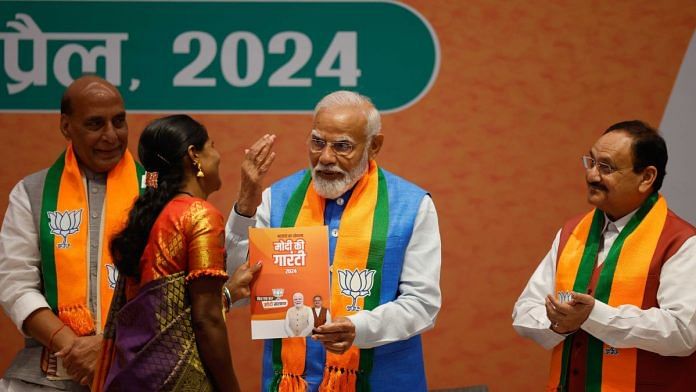The BJP’s election manifesto is teeming with promises to lure India’s youth and business community–its core vote bank. Released shortly before the first phase of elections on 19 April, the ‘Sankalp Patra’ appears tech-savvy and geared toward capturing young voters’ hearts. The ruling party is also eyeing 1.85 crore first-time voters, whom it is strategically targeting with pledges of a digital revolution.
BJP plans to court the retail juggernaut while recognising that traditional trade cannot thrive without a digital makeover: This is where the Open Network for Digital Commerce (ONDC), a protocol that facilitates e-markets, comes in. Promoting the use of ONDC is expected to open new markets for Micro, Small & Medium Enterprises (MSMEs) and protect them from the competitive pressures of major e-commerce players. The party also makes ambitious claims to establish India as a world leader in emerging technologies like artificial intelligence and quantum computing. Yet, amid these grandiose promises of tech supremacy, lurks ambiguity. The manifesto glosses over details like the future of key schemes such as PLI (Performance Linked Incentive) and FAME [Faster Adoption and Manufacturing of (Hybrid &) Electric Vehicles in India].
BJP manifesto silent on key issues
There is significant emphasis on positioning India as a global hub for manufacturing electronic devices, semiconductors, and electric vehicles. Should the Modi government be voted back, it would balance these industrial sectors with a free trade posture. Achieving self-reliance in tech manufacturing is perhaps necessary in an uncertain global landscape. But this endeavour means navigating the complexities of state-supported industrial growth while ensuring the sustainable development of supply chains aligned with global market dynamics. It is a tightrope between safeguarding investor interests–who commit crucial capital to these projects–and securing global market access for long-term viability.
The manifesto sets out lofty goals but remains silent on addressing key issues like implementation strategy, legal reforms, and policy predictability. Three glaring examples stand out:
First, on the manufacturing front, the BJP offers no clarity on the future design of PLI for electronics like smartphones and demand-side subsidies for EVs. Reports hint at the potential restructuring of the PLI scheme to increase its efficiency or even scrap it in sectors where progress is slow, leaving businesses feeling insecure.
Similarly, the FAME scheme is in limbo – with reduced subsidies that have left EV companies in the dark. The absence of clear directives hampers capital expenditure planning and slows investment. The manifesto is a missed opportunity to provide businesses with much-needed clarity.
Second, while the BJP promises to establish India as a frontrunner in emerging tech through initiatives like IndiaAI, its manifesto lacks specifics on execution. The IndiaAI Mission, launched in 2020, received Union cabinet approval this year at an outlay of Rs 10,372 crore to enhance supercomputing capacity (compute, for short). The mission is premised on a public-private partnership model, but the role of the private sector remains unclear. No country has developed quantum computing capabilities without such involvement: private enterprises will be needed for components manufacturing, production and the necessary skill sets. Similarly, India’s Quantum Mission, also requires the private sector but the manifesto overlooks how these partnerships may be developed.
Last, the manifesto’s silence on legal reforms in the digital space is concerning. The outdated Information Technology Act, about two decades old now, remains India’s nodal tech law. It lacks the foresight to accommodate new business models and internet technologies. A legislative proposal to replace the IT Act called the Digital India Bill is in the works but finds no mention in the manifesto, which raises questions about the government’s commitment to policy reliability for fostering businesses, suggesting it may not be a priority.
Election manifestos should play a pivotal role in the democratic process, delineating a party’s vision and aiding voters in informed decision-making. Yet, in an era of incessant social media communication, this manifesto appears outdated. There is a pressing need to revisit political templates for these signalling tools, especially in rapidly evolving sectors like technology, to ensure they are effective in shaping political discussion and voter engagement.
The author works at Koan Advisory Group, a technology policy consulting firm. Views are personal.
This article is part of ThePrint-Koan Advisory series that analyses emerging policies, laws and regulations in India’s technology sector. Read all the articles here.
(Edited by Zoya Bhatti)



